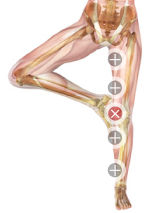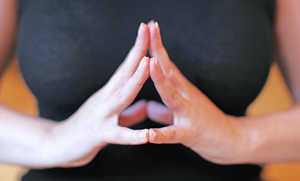Spotlight on a pose: Vrksasana
Vrksasana (Tree pose) is a popular balancing pose. It is easier for most people then many other balancing poses. The symbolism of the tree is easily identified and reflects the qualities of being grounded, stable and rooted into the earth.

From the structural standpoint this pose strongly engages the abductors in addition to challenging balance. Abductors of the straight leg are responsible for keeping the pelvis even while standing on one leg, and abductors of the bent leg are responsible for keeping the hip abducted. Insufficient strength in those muscles can make the pose difficult and unstable, yet this position is very useful for training those areas. Tight inner thigh muscles might prevent the knee from turning outward. That is why it is important to warm up the inner and outer hips before attempting this pose.
Balance + Axial extension – Asymmetrical – Fixed frame
Main purpose: To train balance (reasons to work on balance)
Secondary purpose: To lengthen the spine and strengthen the legs (especially abductors)
How To
Shift the weight of the body to your left foot. Bend your right knee, turn it out and place your right foot on the inside of your left leg. Gently press the foot into the leg and the leg into the foot. Lengthen up through the top of the head creating the sensation of lift through the entire body. Place your palms together in front of the chest. Breathe deeply, continue to turn the right knee out on the inhale and create a corset-like engagement around the waist with every exhale while keeping the pelvis in place. Focus your gaze on a stable point at the eye level or below. Keep you shoulders relaxed.
Feet: You can place your foot on the inner thigh, slightly above the knee, slightly below the knee or near the ankle. The higher you put your foot, the more challenging it will be for the hip. Pick a foot position that will allow you to turn the bent knee out with more ease. Be sure not to place the foot on the inside of the knee joint (pressing sideways on your knee is never a good idea and can lead to injury).
Hands: The position of your arms/hands can add to your balance challenge or make it easier to balance.
– Keeping the arms out to the sides will make it easier to find equilibrium
– Keeping the palms together in front of the chest is a bit more challenging, but might help with focus
– Extending the arms all the way up with palms together is the most challenging version
You can also place your hands into Hakini mudra when you hold the pose. It promotes concentration, helps you focus and is supposed to facilitate cooperation between the right and left brain hemispheres.


